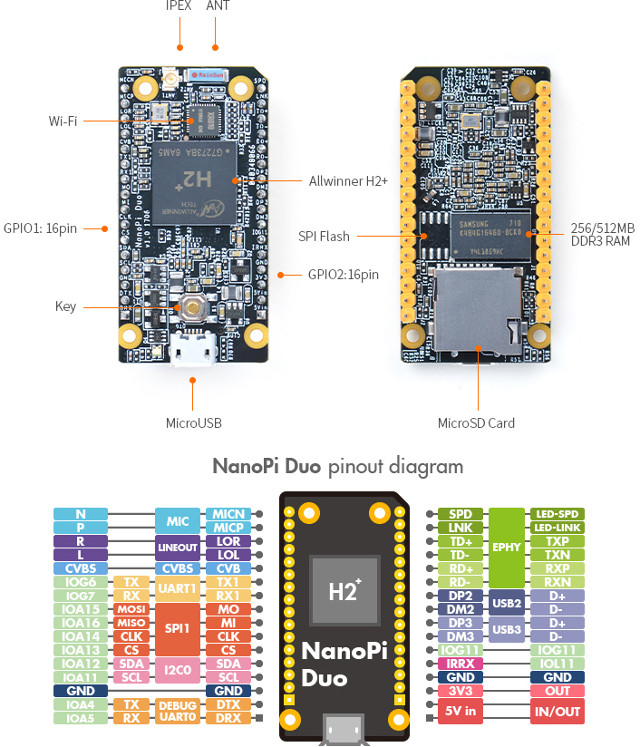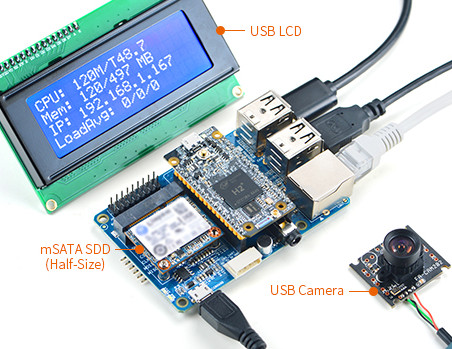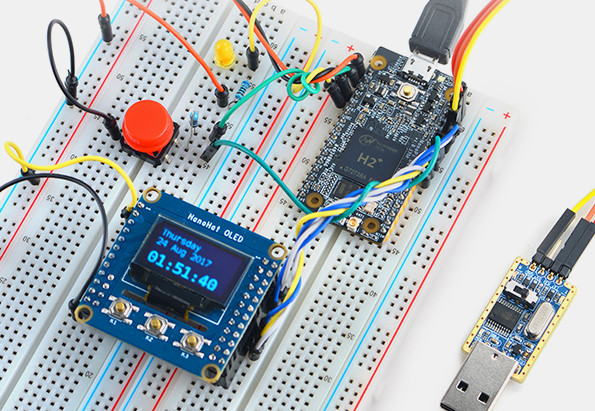It’s very easy to find breadboard compatible boards in the market with products based on Espressif chips such as NodeMCU or ESP32 boards, as well as OpenWrt board like Onion Omega2, or LinktIt 7688. However, it’s much more difficult to find powerful quad core boards in this form factor, but that’s exactly what FriendlyELEC has done with their NanoPi Duo board featuring an Allwinner H2+ quad core processor in a form factor slightly smaller than a Raspberry Pi Zero.
- SoC – Allwinner H2+ quad core Cortex A7 processor @ 1.2 GHz with Mali-400MP2 GPU @ 600 MHz
- System Memory – 256 or 512 MB DDR3-1866 SDRAM
- Storage – micro SD card slot, footprint for SPI flash
- Connectivity – 802.11 b/g/n WiFi (Allwinner XR819 module) with chip antenna, and u.FL/IPEX connector for external antenna
- USB – 1x micro USB OTG port
- Expansion headers – 2x 16-pin breadboard compatible headers with 2x USB host ports, GPIO, UART, SPI, I2C, MIC, Line Out, CVBS (composite video), Ethernet, 5V, 3.3V, and GND
- Misc – 1x key
- Power Supply – 5V via micro USB port
- Dimensions – 50 x 25.4 mm
- Weight – 7.76 grams with headers
- Temperature Range – -40°C to +80°C
 An optional heatsink covering most of the board has also being designed in order to deliver optimal performance under load.
An optional heatsink covering most of the board has also being designed in order to deliver optimal performance under load.
The company provides an image based on U-boot, Linux 4.11.2, and Ubuntu 16.04.2 Xenial for the board, which you can find in the Wiki, together with the rest of the software and hardware documentation including schematics (PDF) and mechanical design files.

In order to experiment the I/Os on the board, FriendleELEC also provides what they call “NanoPi Duo mini Shield” exposing the following interfaces:
- Storage – Half-size mSATA slot via JMS567 USB to SATA controller
- Connectivity – 1x 10/100M Ethernet port
- USB – 4x USB host port
- Audio – Built-in microphone, and 3.5mm audio jack
- Debugging – 4-pin connector for serial console
- Expansion – 2x 9-pin GPIO header with I2C, SPI, UART, and GPIO; 6-pin SPI header
- Misc – SSD and Power LEDs
- Power Supply – 5V via micro USB port
- Dimensions – 85 x 56 mm (Compatible with Raspberry Pi 3 cases)
Documentation for the mini shield is located in a separate wiki page.
NanoPi Duo sells for $7.99 with 256MB RAM, $11.99 with 512MB, plus shipping. You may consider adding the $2.99 option for the heatsink, and while you can also add the mini shield for $9.98, the “NanoPi Duo Starter Kit” may be a better option as it goes for $17.98 with all accessories you may need for a complete system.
Thanks to theguyuk for the tip.

Jean-Luc started CNX Software in 2010 as a part-time endeavor, before quitting his job as a software engineering manager, and starting to write daily news, and reviews full time later in 2011.
Support CNX Software! Donate via cryptocurrencies, become a Patron on Patreon, or purchase goods on Amazon or Aliexpress





